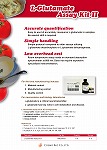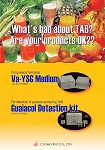this page: Food and Beverage Related Assays and Reagents Dashboard
Products on this page
Fruit Juice Quality Control
Common Allergen Lateral Flow Assays
Common Pathogen Lateral Flow Assays
Water Quality
Assays
Oxidative Stress
Analytical Standards
Product Brochures
Food and Juice Related Research Products
Common Food Allergen Detection: "FAST KIT ELISA Ver. III" and "FastKit Slim" (research use only)
* L-Glutamate Assay Kit II
* L-Glutamate Oxidase 25 Enzyme
Water Quality

17(BETA)-Estradiol EIA (for an environment monitor)
- This EIA kit is used for quantitative determination of 17''BETA''-estradiol in environmental water and culture supernatant. The kit is characterized for sensitive quantification, high specificity and easy handling.
| Product Name | Catalog Number |
| 17(BETA)-Estradiol EIA (for an environment monitor) | YII-YK170-EX |
Background
Introduction Estrogen is now known to include over 20 kinds of related steroidal compounds. Among them, estrone (E1), estradiol (E2), and estriol (E3) are most abundant in the human body. These three are highly stable, to which other estrogen - related steroidal compounds are shown to be transformed rapidly in the metabolic processes. Recently, estrogen is attracting public attention as an environmental pollutant, especially in rivers and wastewater. The assessment of such pollution is therefore an important issue to protect people from the adverse estrogenic effects of the pollutant. Some immunoassay kits are already available commercially for measurement of estrogen, but only in blood and not in environmental materials and culture supernatant. As a part of the developments of a series of estrogen immunoassay kits, we produced the immunoassay kit for measurement of 17-estradiol in environmental water and culture supernatant, especially in rivers and wastewater. We present this kit is characterized by its high specificity, sensitivity and easy handling.
Characteristics
This EIA kit is used for quantitative determination of 17- estradiol in environmental water and culture supernatant. The kit is characterized for sensitive quantification, high specificity and easy handling.
>Specificity>
The EIA kit shows no cross reactivity to testosterone, estrone, progesterone, estriol and cholesterol.
>Test Principle>
This EIA kit for determination of 17-estradiol in environmental water and culture supernatant sample is based on a competitive enzyme immunoassay using combination of highly specific antibody to 17-estradiol and biotin-avidin affinity system. The 96-wells plate is coated with goat anti rabbit IgG. Biotinylated 17-estradiol, 17-estradiol standard or samples and rabbit anti 17-estradiol are added to the wells for competitive immunoreaction. After incubation and plate washing, HRP labeled streptavidin (SA-HRP) are added to form HRP labeled streptavidin-biotinylated 17- estradiol-antibody complex on the surface of the wells. Finally, HRP enzyme activity is determined by o-phenylenediamine dihydrochloride (OPD) and the concentration of 17-estradiol is calculated.
References
- Goda, Y. et al.: Development of the ELISA for detection of hormone-disrupting chemicals. WATER SCIENCE TECHNOLOGY 42(7-8): 81-88, 2000
- Goda, Y. et al.: Development of the ELISA for detection of estrogenic hormones in environment. IWA 2nd World Water Congress, Berlin, Germany IWA CD-ROM: 269, 2001
- Nichols, D. J. et al.: Runoff of estrogen hormone 17E-estradiol from poultry litter applied to pasture. JOURNAL OF ENVIRONMENTAL QUALITY 26(4): 1002-1006, 1997




